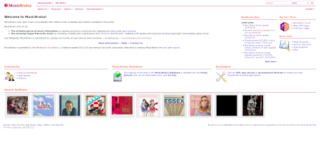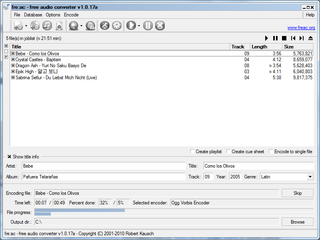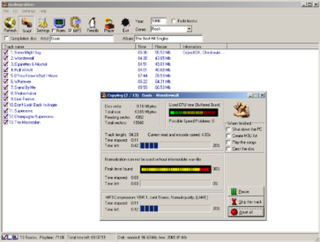Related Research Articles

The compact disc (CD) is a digital optical disc data storage format that was co-developed by Philips and Sony to store and play digital audio recordings. In August 1982, the first compact disc was manufactured. It was then released in October 1982 in Japan and branded as Digital Audio Compact Disc.

MusicBrainz is a MetaBrainz project that aims to create a collaborative music database that is similar to the freedb project. MusicBrainz was founded in response to the restrictions placed on the Compact Disc Database (CDDB), a database for software applications to look up audio CD information on the Internet. MusicBrainz has expanded its goals to reach beyond a CD metadata storehouse to become a structured online database for music.

Compact Disc Digital Audio, also known as Digital Audio Compact Disc or simply as Audio CD, is the standard format for audio compact discs. The standard is defined in the Red Book, one of a series of Rainbow Books that contain the technical specifications for all CD formats.
Freedb was a database of user-submitted compact disc track listings, where all the content was under the GNU General Public License. To look up CD information over the Internet, a client program calculated a hash function from the CD table of contents and used it as a disc ID to query the database. If the disc was in the database, the client was able to retrieve and display the artist, album title, track list and some additional information.

A CD ripper, CD grabber, or CD extractor is software that rips raw digital audio in Compact Disc Digital Audio (CD-DA) format tracks on a compact disc to standard computer sound files, such as WAV or MP3.

K3b is a CD, DVD and Blu-ray authoring application by KDE for Unix-like computer operating systems. It provides a graphical user interface to perform most CD/DVD burning tasks like creating an Audio CD from a set of audio files or copying a CD/DVD, as well as more advanced tasks such as burning eMoviX CD/DVDs. It can also perform direct disc-to-disc copies. The program has many default settings which can be customized by more experienced users. The actual disc recording in K3b is done by the command line utilities cdrecord or cdrkit, cdrdao, and growisofs. As of version 1.0, K3b features a built-in DVD ripper.

AllMusic is an American online music database. It catalogs more than three million album entries and 30 million tracks, as well as information on musicians and bands. Initiated in 1991, the database was first made available on the Internet in 1994. AllMusic is owned by RhythmOne.

CDex is a free software package for Digital Audio Extraction from Audio CD and audio format conversion for Microsoft Windows. It converts CDDA tracks from a CD to standard computer sound files, such as WAV, MP3, or Ogg Vorbis. CDex was previously released as free software under the terms of the GNU General Public License (GPL); however, although the website claims that this is still the case, no source code has been released since 2005. It was originally written by Albert L. Faber, and is developed and maintained by Georgy Berdyshev. Recent versions of the software may be compromised and a security threat.

Quintessential Player was a freeware, multi-format media player developed by Paul Quinn.

Copy Control was the generic name of a copy prevention system, used from 2001 until 2006 on several digital audio disc releases by EMI Group and Sony BMG Music Entertainment in several regions. It should not be confused with the CopyControl computer software copy protection system introduced by Microcosm Ltd in 1989.
AMG LASSO is a media recognition service launched by the All Media Guide in 2004. The LASSO service automatically recognizes CDs, DVDs, and digital audio files in formats such as MP3, WMA, and others. The service uses CD table of contents (ToC), DVD ToC, and acoustic fingerprint based recognition to recognize media. LASSO is available in versions for PCs and embedded devices.
CD/DVD copy protection is a blanket term for various methods of copy protection for CDs and DVDs. Such methods include DRM, CD-checks, Dummy Files, illegal tables of contents, over-sizing or over-burning the CD, physical errors and bad sectors. Many protection schemes rely on breaking compliance with CD and DVD standards, leading to playback problems on some devices.
Exact Audio Copy (EAC) is a CD ripping program for Microsoft Windows. The program has been developed by Andre Wiethoff since 1998. Wiethoff's motivation for creating the program was that other such software only performed jitter correction while scratched CDs often produced distortion.

The Sony Ericsson W850i is the first 3G sliding form factor mobile phone by Sony Ericsson, introduced in Q2 2006. It is a member of their Walkman line. The phone made its first public appearance in the 2006 movie The Da Vinci Code, months before its release. It is similar mechanically to the Sony Ericsson K800i, but differs in its form factor, memory card support of the Memory Stick PRO Duo instead of Memory Stick Micro, and the camera

Gracenote, Inc. is a company and service that provides music, video and sports metadata and automatic content recognition (ACR) technologies to entertainment services and companies, worldwide. Formerly CDDB, Gracenote maintains and licenses an Internet-accessible database containing information about the contents of audio compact discs and vinyl records. From 2008 to 2014, it was owned by Sony, later sold to Tribune Media, and has been owned since 2017 by Nielsen Holdings.

Audiograbber is a proprietary freeware CD audio extractor/converter program for Microsoft Windows. It was one of the first programs in the genre to become popular. The data extraction algorithm was designed by Jackie Franck and was included in the Xing Technology software package Xing Audio Catalyst in the mid-1990s.

A CD-ROM is a type of read-only memory consisting of a pre-pressed optical compact disc that contains data. Computers can read—but not write or erase—CD-ROMs. Some CDs, called enhanced CDs, hold both computer data and audio with the latter capable of being played on a CD player, while data is only usable on a computer.
Sony Digital Audio Disc Corporation is a manufacturer of CDs, DVDs, UMDs, and Blu-ray Discs. The company has many plants worldwide. Although it primarily services Sony Music Entertainment-owned record labels, Sony Pictures Home Entertainment, and Sony Interactive Entertainment, it also manufactures discs for other labels, home entertainment distributors, and video game publishers.
Nero Burning ROM, commonly called Nero, is an optical disc authoring program from Nero AG. The software is part of the Nero Multimedia Suite but is also available as a stand-alone product. It is used for burning and copying optical discs such as CDs, DVDs, Blu-rays. The program also supports label printing technologies LightScribe and LabelFlash and can be used to convert audio files into other audio formats.
Music information company Gracenote changed its database terms to closed-source in 2001. This caused some controversy because Gracenote's ancestor, CDDB, had previously said its database was released under the GPL.
References
- ↑ Copeland, Michael (2004-03-01). "The Magic Behind the Music". Business 2.0. Retrieved 2009-05-23.
- ↑ Dean, Katie (2004-07-07). "The House That Music Fans Built". Wired. Retrieved 2009-05-23.
- ↑ Kan, Ti (2004-04-21). "Change History" . Retrieved 2007-10-19.
- ↑ "What is Gracenote?". Gracenote. Archived from the original on 2007-10-12. Retrieved 2007-10-19.
- ↑ Kan, Ti (2005-11-16). "Ti Kan: Software" . Retrieved 2007-10-19.
- ↑ "Gracenote: Company Info". Gracenote. Archived from the original on 2007-10-14. Retrieved 2007-10-19.
- ↑ WIRED Staff. "Gracenote Defends Its Evolution". Wired. ISSN 1059-1028 . Retrieved 2023-12-10.
- ↑ "CDDB Re-Launches As Gracenote With New Products" (Press release). Gracenote. 2000-07-24. Archived from the original on 2010-04-25. Retrieved 2010-01-25.
- ↑ "CDDB, World's Largest Online CD Music Database, Debuts New Web Site" (Press release). Gracenote. 1999-04-27. Archived from the original on 2010-11-20. Retrieved 2010-01-25.
- 1 2 Haas, Karl-Gerhard (2020-06-23). "CD-Datenbanken: freedb ist tot, es leben die Alternativen!". heise online (in German). Retrieved 2023-12-10.
- 1 2 Van Buskirk, Eliot (2006-11-13). "Gracenote Defends Its Evolution". Wired. ISSN 1059-1028 . Retrieved 2023-12-10.
- 1 2 "Why freedb.org?". freedb. Archived from the original on 2004-10-13. Retrieved 2007-10-19.
- ↑ "Gracenote News: Sony Corporation of America Completes Gracenote Acquisition". Archived from the original on 2008-06-10.
- ↑ Tribune to merge Media Services into Gracenote operations, 2014-06-14
- ↑ Tribune Media Agrees To Sell Gracenote Data Services To Nielsen For $560M, 2016-12-20
- ↑ "Gracenote: Frequently Asked Questions". Archived from the original on 2008-04-18. Retrieved 2018-04-10.
- ↑ "iTunes Mac 8.2 Help: Sending CD information to the Gracenote media database". Docs.info.apple.com. Retrieved 2018-04-10.[ permanent dead link ]
- ↑ Sedgewick, Robert; Wayne, Kevin (2007-03-05). "CDDB.java". Princeton University Computer Science Department. Archived from the original on 2008-02-11. Retrieved 2007-10-19.
- ↑ Tips on using CD Trustee – Classical music Archived 2008-06-06 at the Wayback Machine
- ↑ "Taming iTunes for Classical Music". Oakroadsystems.com. Retrieved 2018-04-10.
- ↑ "Classical Music Initiative". Gracenote. Archived from the original on 2008-04-18. Retrieved 2008-04-23. For the original 2007-01-08 press release, see: archive.org archive, or findarticles.com archive.
- ↑ "Roll Over Beethoven: iTunes' New Standard". CBS News . Associated Press. 2007-01-09. Retrieved 2008-04-23.